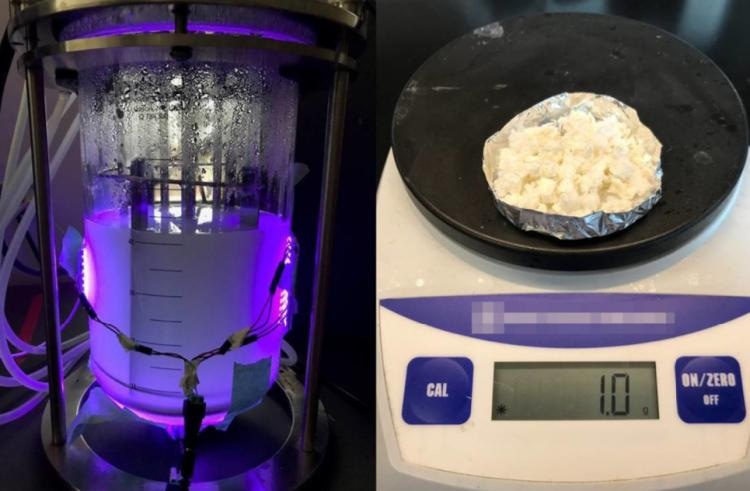Jun 12 2019
Researchers at the University of Colorado Boulder (CU Boulder) have successfully produced nanobio-hybrid organisms that can use airborne nitrogen and carbon dioxide (CO2) to create a wide range of fuels and plastics.
 A gram of biodegradable plastic created by nanobio-hybrid microbes developed by CU Boulder engineers. (Image credit: Nagpal Lab/University of Colorado Boulder
A gram of biodegradable plastic created by nanobio-hybrid microbes developed by CU Boulder engineers. (Image credit: Nagpal Lab/University of Colorado Boulder
This breakthrough development provides the first promising step toward eco-friendly manufacturing of chemicals and low-cost sequestration of carbon.
When the researchers used light-activated quantum dots to fire specific enzymes inside microbial cells, they were able to produce “living factories” that ingest harmful CO2 and change it into useful products like biodiesel, ammonia¸ gasoline, and biodegradable plastic.
The innovation is a testament to the power of biochemical processes. We’re looking at a technique that could improve CO2 capture to combat climate change and one day even potentially replace carbon-intensive manufacturing for plastics and fuels.
Prashant Nagpal, Study Lead Author and Assistant Professor, Department of Chemical and Biological Engineering, CU Boulder
The project was initiated in 2013, when Nagpal and his coworkers started to explore the huge potential of nanoscopic quantum dots, which are essentially very small semiconductors akin to those utilized in television sets. These quantum dots can be passively administered into the cells and are specifically designed to adhere and self-assemble to preferred enzymes and subsequently stimulate these enzymes on command using particular wavelengths of light.
Nagpal wanted to find out whether quantum dots could serve as a spark plug to fire specific enzymes inside the microbial cells that have the ability to transform airborne nitrogen and CO2, but fail to do so naturally because of the absence of photosynthesis.
When Nagpal and his team diffused the uniquely-made dots into the cells of common microbial species present in the soil, they were able to bridge the gap. Now, the microbes’ CO2 appetite would be activated even when they are exposed to only small amounts of indirect sunlight, which means, food or other sources of energy is no longer required to perform the energy-intensive biochemical conversions.
Each cell is making millions of these chemicals and we showed they could exceed their natural yield by close to 200%.
Prashant Nagpal, Study Lead Author and Assistant Professor, Department of Chemical and Biological Engineering, CU Boulder
Lying dormant in water, the microorganisms discharge their ensuing product to the surface, where it can be removed and harvested for subsequent manufacturing.
Varied combinations of light and dots create different products—while green wavelengths make the bacteria to ingest nitrogen and release ammonia, redder wavelengths make the pathogens to feast on CO2 to generate plastic instead.
Moreover, the process demonstrates viable signs of being able to work at scale. The study discovered that even when the microbial factories were consistently stimulated for hours at a time, they exhibited few signs of depletion or exhaustion. This indicates that the cells are capable of regenerating and thus restrict the requirement for rotation.
“We were very surprised that it worked as elegantly as it did,” Nagpal said. “We’re just getting started with the synthetic applications.”
According to Nagpal, the ideal futuristic scenario would be to have businesses and single-family homes to pipe their emissions of CO2 directly to a close by holding pond, where the pathogens would be able to change them into a bioplastic. The resulting product can be sold by the owners for a small profit and this would allow them to offset their own carbon footprint.
Even if the margins are low and it can’t compete with petrochemicals on a pure cost basis, there is still societal benefit to doing this. If we could convert even a small fraction of local ditch ponds, it would have a sizeable impact on the carbon output of towns. It wouldn’t be asking much for people to implement. Many already make beer at home, for example, and this is no more complicated.
Prashant Nagpal, Study Lead Author and Assistant Professor, Department of Chemical and Biological Engineering, CU Boulder
Nagpal stated that the focus will currently shift to improve the conversion process and bring on fresh undergraduate students. Nagpal is seeking ways to transform the project into an undergraduate laboratory experiment in the fall semester, funded by a CU Boulder Engineering Excellence Fund grant. He also credits his present students for remaining in the project over the course of several years.
“It has been a long journey and their work has been invaluable,” he stated. “I think these results show that it was worth it.”